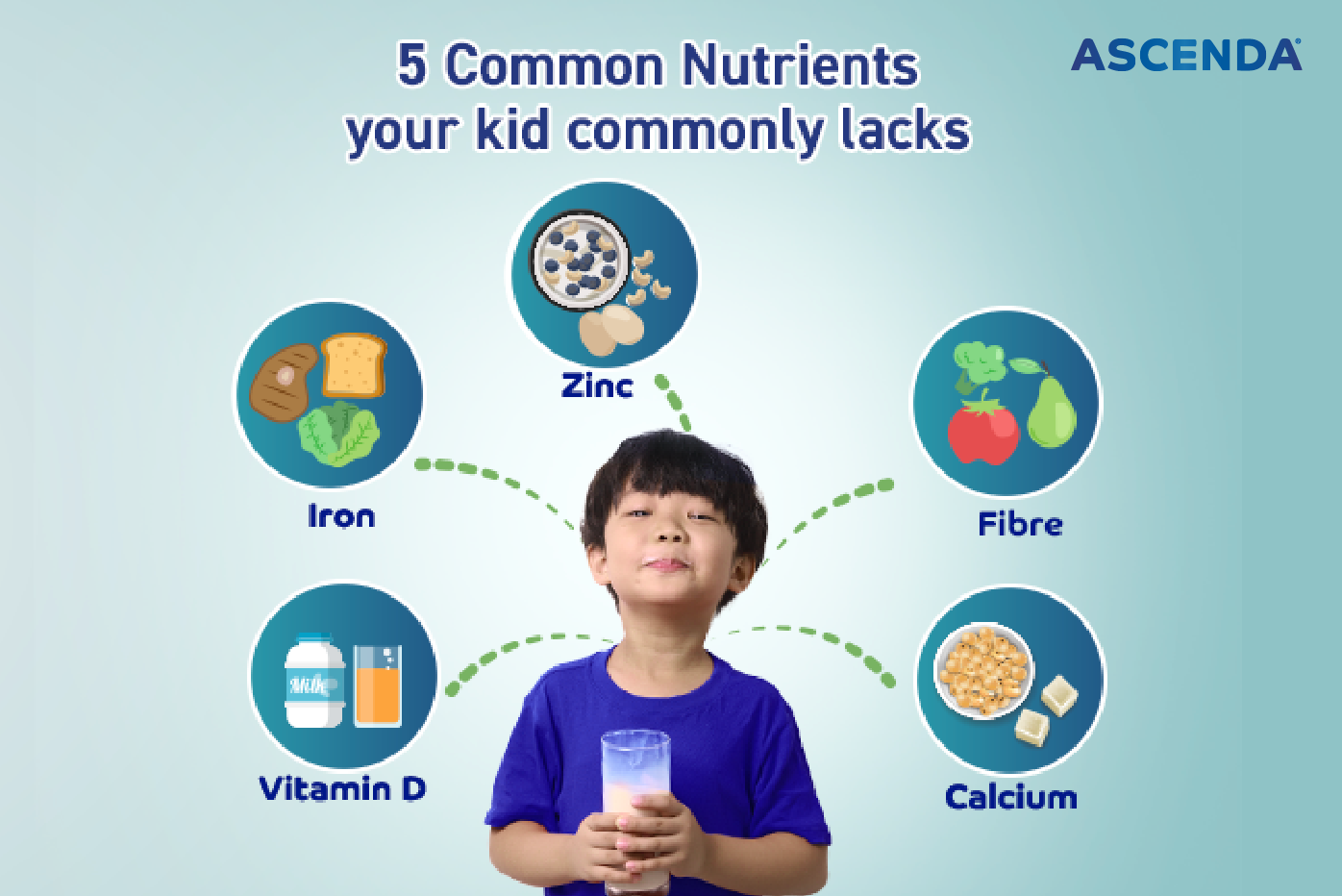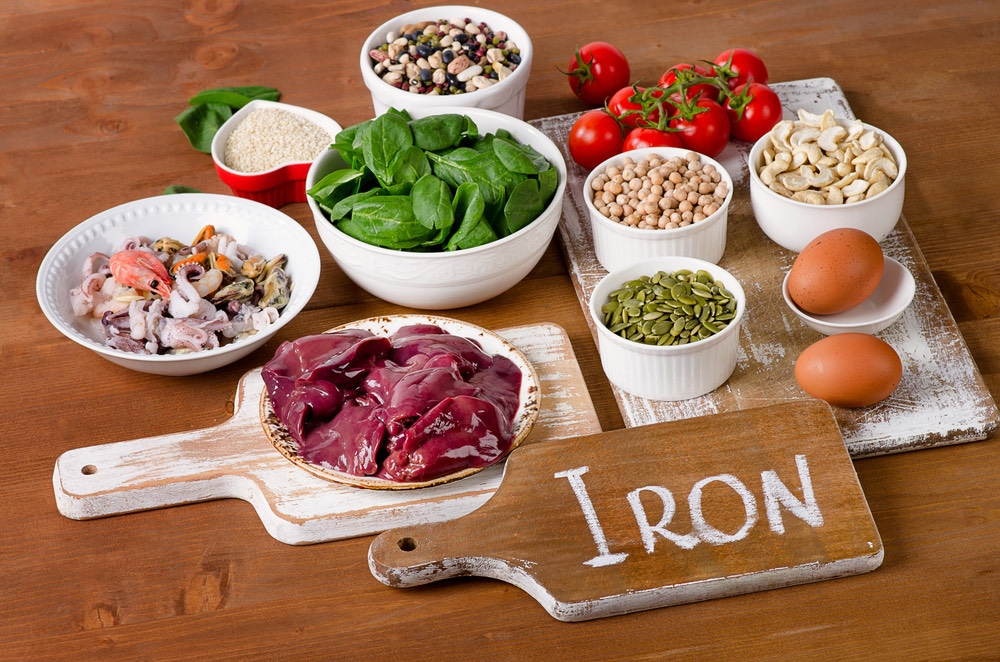
Nutritional Deficiencies in Children
Nutritional deficiencies in children are not uncommon but they are often overlooked. Did you know even if your child eats regularly, there is a possibility that they might not be getting all the nutrients they need to grow strong and healthy? Most of your child's brain development happens by the age of five. That's why it's important to give them the right building blocks - essential nutrients! These right nutrients help the body grow and develop according to age and potential while keeping the children healthy by strengthening the immune system.
It is no secret that kids prefer eating junk food and consuming sugary drinks over healthy food but more often this can actually lead to nutritional deficiencies that can affect their development and well-being. For example, studies show that nutritional deficiencies in children can impair physical development, reduce cognitive function, and reduce immunity. As a matter of fact, there is also a study that shows a surprising link between nutritional deficiencies and behavioural problems among children.
Every bite certainly counts! Let's deep dive into some of the nutritional deficiencies that are most common in children.
What are the most common nutritional deficiencies in children?

Iron
When we talk about nutritional deficiencies, iron deficiency is commonly recognised as a major concern. Iron is a vital nutrient, a major component of blood that carries oxygen to cells all over the body. It is also essential to promote growth and development, as well as immune function, reproduction, and wound healing.
What happens when children do not have enough iron in their body? Their red blood cells can't carry enough oxygen to their organs and muscles. Iron deficiency anaemia in children occurs in those with more severe deficiency of iron. This can lead to them feeling lethargic and weak, experiencing difficulty concentrating, having a shorter attention span, and behavioural disorders. Did you know? Teenage girls require double the amount of iron than boys due to the menstruation as it contributes to the higher losses of iron.
Here is how much iron your kids need, depending on their age.
- 1-3 years: 6 mg per day
- 4-6 years: 6 mg per day
- 7-9 years: 9 mg per day
Iron can easily be found in meat, liver, chicken, seafood (anchovies, cockles) and egg yolks. Vegetarian food sources of iron include fried soya bean curd, dark leafy vegetables (such as spinach, fern shoots or pucuk paku, kangkung), legumes, dried fruits, iron-fortified cereals, breads, and pastas. You can also find iron and other essential micronutrients in fortified growing-up milk.

Zinc
Another important nutrient is zinc for kids. This is an important mineral needed for optimal growth, strong immunity, regulation of growth hormone, cognitive functioning, healthy digestion in children and even taste and smell!
Research also suggests that zinc deficiency in children has been linked to poor immunity, impaired growth, slow wound healing, weakened memory, learning disabilities, and poor attention span. In fact, it can also negatively impact appetite and growth, potentially contributing to stunted development in children.
Here is how much zinc dosage for your child, by age.
- Boys:
1 - 3 years: 4.2 mg per day
4 - 6 years: 5.2 mg per day
7 - 9 years: 5.7 mg per day - Girls:
1 - 3 years: 4.0 mg per day
4 - 6 years: 5.2 mg per day
7 - 9 years: 5.6 mg per day
Including zinc-rich foods in your child's daily meals is a great way to ensure they get the nutrients they need to thrive. Zinc can be found in a variety of foods such as lean meat (e.g. beef), organ meats (e.g. liver from beef, poultry), shellfish (especially oysters), nuts, seeds, legumes and whole grain cereals (especially bran and germ). Formula milk for children is also fortified with zinc and other essential micronutrients.

Calcium
Did you know, over 99% of the body's calcium is found in the bones? Calcium is crucial for your little ones! It helps them build strong bones and teeth, which are essential for healthy growth and development throughout childhood. Calcium also keeps the nerves and muscles working. It plays a key role in keeping the heart healthy.
While a healthy diet typically provides sufficient calcium for most children, there are some signs that may indicate your child might experience calcium deficiency. These signs can include dry skin, hair, and nails, as well as muscle cramps. In rare cases, untreated calcium deficiency in children can lead to more serious issues like rickets, stunted growth, weakened tooth enamel, and even seizures.
Here is how much calcium your kids need.
- 1 to 3 years old: 700 mg per day
- 4 to 6 years old: 1,000 mg per day
- 7 to 9 years old: 1000 mg per day
Milk and dairy products like yogurt and cheese are excellent sources for calcium. Fish with edible bones, like canned sardines and anchovies, also pack a calcium punch. But please be wary when giving these foods as they may cause choking in young children. Consider mashing or breaking down the fish to a finer consistency for younger children.
For plant-based options, explore beans and bean products (including yellow dhal, tofu, and tempeh), and even locally processed foods like shrimp paste, cincaluk, and budu. Vegetables like spinach, watercress, mustard leaves, star gooseberry (cekur manis), tapioca leaves, kai-lan, and broccoli can also contribute calcium.
Remember, vitamin D helps the body absorb calcium, so ensuring your child gets enough of both is crucial for their healthy growth and development.

Vitamin D
Every child needs vitamin D, which is essential for optimal bone growth, a strong immune system, and heart health. This fat-soluble vitamin is also crucial for the absorption of essential nutrients, including calcium, iron, magnesium, zinc, and phosphate. Vitamin D deficiency in kids can result in impaired growth, softening of the bones, and rickets (skeletal deformities). Some of the Vitamin D deficiency symptoms in children are muscle weakness, cramps, bone pain and feeling depressed. Studies also show that Vitamin D deficiency is linked to aggressive behaviour, anxiety and depression during adolescence.
Here is how much Vitamin D your kids need, by age:
- 1-9 years: 15 mcg per day
Sunshine plays a key role in how your child gets vitamin D! Their body can naturally create it when exposed to sunlight. However, not many foods boost vitamin D naturally. Luckily, some great sources include oily fish (like salmon, tuna, and sardines), along with beef liver, cod liver oil, and egg yolks. Don't forget, foods fortified with vitamin D offer another great way to boost their intake!


Fibre
Fibre is a type of carbohydrate that our bodies can't fully digest, and plays a crucial role in your child's well-being. It helps promote regular bowel movements, preventing uncomfortable constipation. Additionally, fibre contributes to improved heart health and supports the growth of beneficial gut bacteria, which are essential for a healthy immune system.
Fibres such as prebiotics help to promote growth of good bacteria in the gut. Lack of prebiotics in the diet may cause these beneficial bacteria to decrease, making your child more susceptible to gastrointestinal infections.
Here is how much fibre your kids need, by age:
- 5 years old : 10-15g per day
- 10 years old : 15-20g per day
- 15 years old : 20-25g per day
Fibre-rich foods include wholegrains (such as quinoa, oatmeal, whole-wheat bread, and brown rice), spinach, pears, apples, raspberries, green peas, broccoli, beans and lentils, and nuts and seeds.
If you're aiming to increase the fibre in your child's diet, be sure to introduce it gradually over a few weeks. Adding too much fibre too quickly can cause bloating, gas, and cramps. It's also important to ensure your child drinks plenty of water, which will help the fibre move smoothly through their intestines.

How can we prevent nutritional deficiencies in children?
So the big question now is, what can you, as parents do to ensure that your kids are getting the nutrients they need to support growth and learning in those crucial early years? Here are some tips:
- Use the “Quarter, Quarter, Half”(QQH) approach as a guide for a balanced diet:
Fill a quarter of your plate with wholegrains (like brown rice, wholemeal bread, wholegrain noodles)
➢ A quarter of your plate should have good sources of protein (such as meat, poultry, fish, eggs, tofu, and dairy products like milk, yoghurt, and cheese)
➢ Make sure that half of your plate is filled with fruits and vegetables. - Make sure your child drinks enough water up to 6 to 8 glasses every day. This is essential to keep the body hydrated, flushes out toxins and carries nutrients.
- Some kids might struggle to get all the nutrients they need just from food, especially picky eaters or those on strict plant-based diets. This can be because they might not eat enough fruits, veggies, or meat, leading to lower levels of energy, protein, vitamins, and minerals.
- To help your picky eater get all the good stuff they need, consider adding a specially designed milk formula to their diet. These milks often have higher vitamins and minerals packed into each calorie compared to regular milk, like a "nutritional upgrade." Look for options that are also lower in sugar or contain zero sugar.
For children who might not be getting all the nutrients they need for healthy growth, paediatricians may recommend a supplement. Ascenda is an energy and nutrient dense formula milk packed with 38 essential nutrients to help ensure your child gets the nutrients they need to reach their full growth potential including iron, zinc, folic acid, vitamins A, B6, B12, C, and D. But most importantly, it's rich in protein and calcium, the key building blocks for healthy bones and muscles. This formula helps to address nutritional gaps in your child's diet and contribute to their optimal growth.
With just two servings a day, you can feel confident your child is getting the necessary building blocks required to support their growth trajectory. By incorporating Ascenda into your child's daily routine, you can help to address the nutritional deficiencies to support health growth while simultaneously helping to establish healthy eating habits.
References:
1 Kar BR, Rao SL, Chandramouli BA. Cognitive development in children with chronic protein energy malnutrition. Behav Brain Funct. 2008;4:31.
2 Piwoz E, Sundberg S, Rooke J. Promoting healthy growth: what are the priorities for research and action? Adv Nutr. 2012;3(2):234-41.
3 Zadik Z, Sinai T, Zung A, Reifen R. Effect of nutrition on growth in short stature before and during growth-hormone therapy. Pediatrics. 2005;116(1):68-72.
4 Ghosh AK, Kishore B, Shaikh I, et al. Continuation of oral nutritional supplementation supports continued growth in nutritionally at-risk children with picky eating behaviour: A post-intervention, observational follow-up study. J Int Med Res. 2018;46(7):2615-32.
5 Huynh DT, Estorninos E, Capeding MR, et al. Impact of long-term use of oral nutritional supplement on nutritional adequacy, dietary diversity, food intake and growth of Filipino preschool children. J Nutr Sci. 2016;5(e20):1-11.
6 Huynh DT, Estorninos E, Capeding RZ, Oliver JS, Low YL, Rosales FJ. Longitudinal growth and health outcomes in nutritionally at-risk children who received long-term nutritional intervention. J Hum Nutr Diet. 2015;28(6):623-35.
7 Sheng X, Tong M, Zhao D, et al. Randomized controlled trial to compare growth parameters and nutrient adequacy in children with picky eating behaviors who received nutritional counseling with or without an oral nutritional supplement. Nutr Metab Insights. 2014;7:NMI-S15097.
8 Alarcon PA, Lin LH, Noche Jr M, et al. Effect of oral supplementation on catch-up growth in picky eaters. Clin Pediatr. 2003;42(3):209-17.
9 Ada’s Medical Knowledge Team 2022. Vitamin Deficiency Test. Taken from https://ada.com/micronutrients/vitamin-deficiency-test/
10National Coordinating Committee on Food and Nutrition Ministry of Health Malaysia Putrajaya. Recommended Nutrient Intakes for Malaysia 2017

